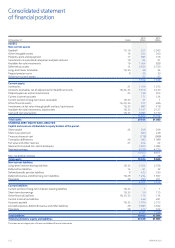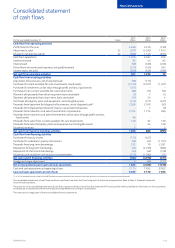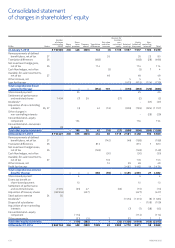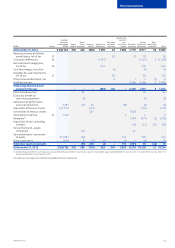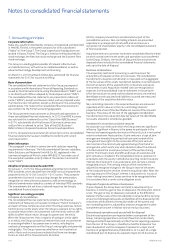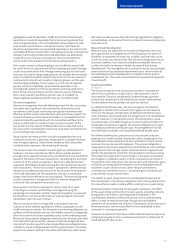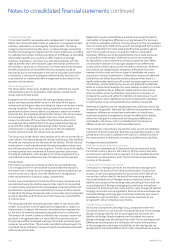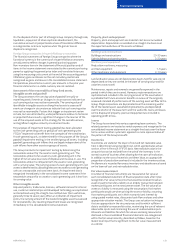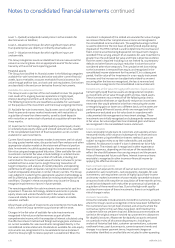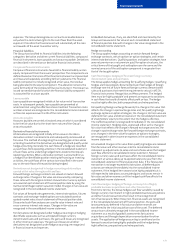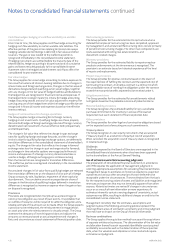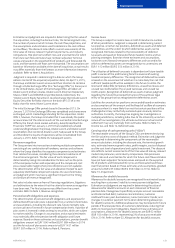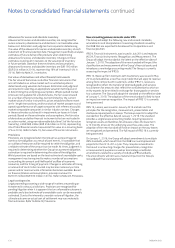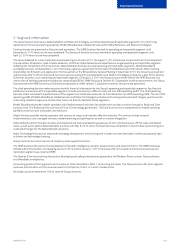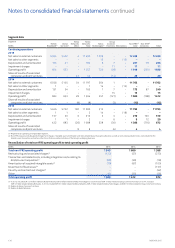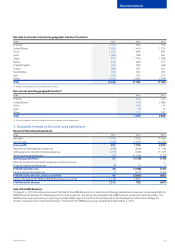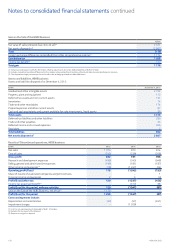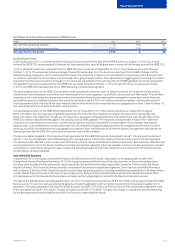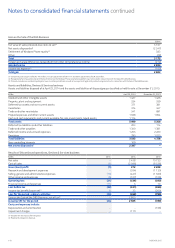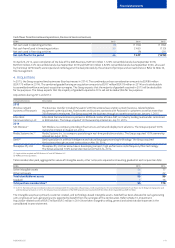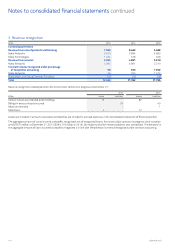Nokia 2015 Annual Report Download - page 134
Download and view the complete annual report
Please find page 134 of the 2015 Nokia annual report below. You can navigate through the pages in the report by either clicking on the pages listed below, or by using the keyword search tool below to find specific information within the annual report.132 NOKIA IN 2015
Cash ow hedges: hedging of cash ow variability on variable
rateliabilities
From time to time, the Group applies cash ow hedge accounting for
hedging cash ow variability on certain variable rate liabilities. The
eective portion of the gain or loss relating to interest rate swaps
hedging variable rate borrowings is deferred in fair value and other
reserves. The gain or loss related to the ineective portion is
recognized immediately in the consolidated income statement.
Ifhedging instruments are settled before the maturity date of the
related liability, hedge accounting is discontinued and all cumulative
gains and losses recycled gradually to the consolidated income
statement when the hedged variable interest cash ows aect the
consolidated income statement.
Fair value hedges
The Group applies fair value hedge accounting to reduce exposure to
fair value uctuations of interest-bearing liabilities due to changes in
interest rates and foreign exchange rates. Changes in the fair value of
derivatives designated and qualifying as fair value hedges, together
with any changes in the fair value of hedged liabilities attributable to
the hedged risk, are recognized in nancial income and expenses. If
the hedged item no longer meets the criteria for hedge accounting,
hedge accounting ceases and any fair value adjustments made to the
carrying amount of the hedged item while the hedge was eective are
recognized in nancial income and expenses based on the eective
interest method.
Hedges of net investments in foreign operations
The Group applies hedge accounting for its foreign currency
hedgingon net investments. Qualifying hedges are those properly
documented hedges of foreign exchange rate risk of foreign currency
denominated net investments that are eective both prospectively
and retrospectively.
The change in fair value that reects the change in spot exchange
rates for qualifying foreign exchange forwards, and the change in
intrinsic value for qualifying foreign exchange options, are deferred in
translation dierences in the consolidated statement of shareholder’s
equity. The change in fair value that reects the change in forward
exchange rates less the change in spot exchange rates for forwards,
and changes in time value for options are recognized in nancial
income and expenses. If a foreign currency denominated loan is
usedas a hedge, all foreign exchange gains and losses arising
fromthetransaction are recognized in translation dierences.
Theineective portion is recognized immediately in the consolidated
income statement.
Accumulated changes in fair value from qualifying hedges are released
from translation dierences on the disposal of all or part of a foreign
Group company by sale, liquidation, repayment of share capital or
abandonment. The cumulative amount or proportionate share of
changes in the fair value of qualifying hedges deferred in translation
dierences is recognized as income or expense when the gain or loss
on disposal is recognized.
Provisions
Provisions are recognized when the Group has a present legal or
constructive obligation as a result of past events, it is probable that
anoutow of resources will be required to settle the obligation and a
reliable estimate of the amount can be made. When the Group expects
a provision to be reimbursed, the reimbursement is recognized as
anasset only when the reimbursement is virtually certain. The Group
assesses the adequacy of its existing provisions and adjusts the
amounts as necessary based on actual experience and changes in
facts and circumstances at each statement of nancial position date.
Restructuring provisions
The Group provides for the estimated cost to restructure when a
detailed formal plan of restructuring has been completed, approved
bymanagement, and announced. Restructuring costs consist primarily
of personnel restructuring charges. The other main components are
costs associated with exiting real estate locations, and
divestment-related charges.
Warranty provisions
The Group provides for the estimated liability to repair or replace
products under warranty at the time revenue is recognized. The
provision is an estimate based on historical experience of the level
ofrepairs and replacements.
Project loss provisions
The Group provides for onerous contracts based on the lower of
theexpected cost of fullling the contract and the expected cost of
terminating the contract. An onerous contract is a contract in which
the unavoidable costs of meeting the obligations under the contract
exceed the economic benets expected to be received under it.
Litigation provisions
The Group provides for the estimated future settlements related
tolitigation based on the probable outcome of potential claims.
Material liability provisions
The Group recognizes the estimated liability for non-cancellable
purchase commitments for inventory in excess of forecasted
requirements at each statement of nancial position date.
Other provisions
The Group provides for other legal and constructive obligations based
on the expected cost of executing any such commitments.
Treasury shares
The Group recognizes its own equity instruments that are acquired
(“treasury shares”) as a reduction of equity at cost of acquisition.
Whencancelled, the acquisition cost of treasury shares is recognized
inretained earnings.
Dividends
Dividends proposed by the Board of Directors are recognized in the
consolidated nancial statements when they have been approved
bythe shareholders at the Annual General Meeting.
Use of estimates and critical accounting judgments
The preparation of consolidated nancial statements in accordance
with IFRS requires the application of management judgment in
selecting appropriate assumptions for calculating nancial estimates.
Management bases its estimates on historical experience, expected
outcomes and various other assumptions that are believed to be
reasonable under the circumstances. These estimates form the basis
for the reported carrying values of assets and liabilities and recognized
revenues and expenses that may not be readily apparent from other
sources. Material estimates are revised if changes in circumstances
occur or as a result of new information or more experience. As
estimates inherently contain a varying degree of uncertainty, actual
outcomes may dier, resulting in additional charges or credits to the
consolidated income statement.
Management considers that the estimates, assumptions and
judgments about the following accounting policies represent the
mostsignicant areas of estimation uncertainty and critical judgment
that may have an impact on the Group’s nancial information.
Business combinations
The Group applies the acquisition method to account for acquisitions
of separate entities or businesses. The determination of the fair value
and allocation thereof to each separately identiable asset acquired
and liability assumed as well as the determination of the acquisition
date, when the valuation and allocation is to be conducted require
estimation and judgment.
Notes to consolidated nancial statements continued


